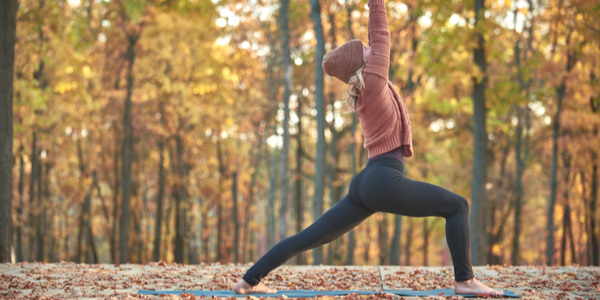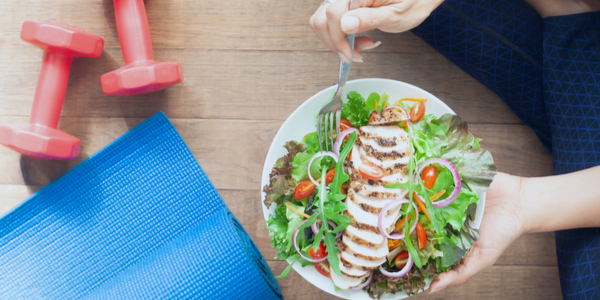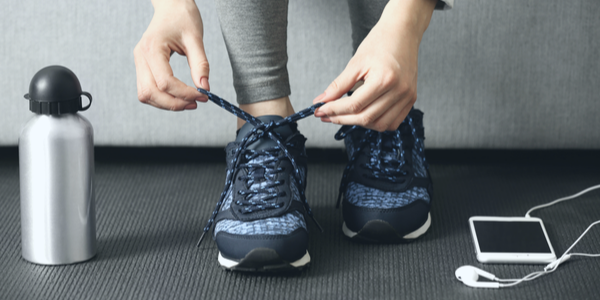
While the warm summer months are arguably the most popular time to work out, movement is a necessary year-round endeavor. And "fit fall" is just around the corner!
Most people know the importance of fitness but may not know how to get started, especially when the temps start dropping.
But look no further! This serves as a comprehensive guide to fall fitness, including fall workouts to inspire autumn weight loss if necessary.
8 Tips to Stay Fit Through Fall
Ready to get started? Follow the below steps and tips to create and sustain a fall fitness routine, as well as use it during all times of the year!
1. Create Fitness Goals
When starting or reevaluating a fitness journey, it is important to set goals to remain motivated and focused. Not everyone needs to make tremendously lofty goals like making it to the Olympics, but goals serve as inspiration and provide direction.
To create meaningful goals, keep the SMART blueprint in mind where the acronym stands for Specific, Measurable, Achievable, Realistic, and Timely. Doing this ensures goals are targeted to current abilities, fitness levels, and lifestyles.
Some ideas of SMART fall fitness goals include:
• I will exercise for 30 minutes on four days of the week and include two active rest days per week.
• I will run a 5k under 35 minutes within two months.
• I will commit to cardio, strength training, and walking six days a week (2x each).
• I will join two or three recreational sports to enjoy this fall in addition to walking 20 minutes a day most days of the week.
• I will include 20 to 45 minutes of non-exercise physical activity 3 to 4 days per week.
• I will include 20 grams of protein at all three main meals and get 25 to 35 grams of fiber per day.
Adapt and modify goals as needed, especially as progress and commitment become more apparent.
2. Take the First Step
After setting goals, it is time to take the first leap… Or step or press or pull, whathaveyou! At one point, every Olympian was brand new at their sport. Everyone starts somewhere and there is no shame in starting small and progressing from there.
Sometimes taking the first step looks like walking on lunch breaks or exercising one day a week. Or, having a dance party in the kitchen after dinner every evening! Whatever the case may be, it is just important to begin.
Referring back to the above point, goal setting can help steer that first step. Create one to two major goals, max, and then consider what smaller goals will help achieve those larger ones.
If the ultimate goal is to walk a 5k, a small beginning goal may be to walk 10 minutes every day for a week. Take it a step further and progress by 3 to 5 more minutes per day, week after week. On the other hand, if the ultimate goal is loftier, like achieving 10 pull-ups, the small goals might need to be slightly more aggressive.
But no matter what, in the famous words of Nike, "Just do it." Commit to the first step and the rest will feel easier.
3. Create Accountability
Accountability is a cornerstone of sticking with most goals. Humans were literally designed to be social creatures that rely on each other to some extent. Plus, experimental and certainly anecdotal evidence suggests goals are more often achieved when shared with others. Not only can friends and family extend encouragement, it innately inspires one to stick with their plan.
However, for the exceptionally dedicated individual, creating accountability could simply mean writing down goals on paper and hanging them on the fridge. One might also create a training plan/schedule and cross off the sessions as completed.
There is really no one right way to create accountability, but it is vital to do this in some fashion.
4. Find New Fitness Enjoyment
On a similar note, there is no right way to "fitness" either. Tried running and hated it or attempted strength training in a gym only to never return? Do not sweat it.
Instead, find a different way to sweat or at least get moving! In addition to typical training techniques like walking, jogging, cycling, or weight training, other ways to fitness include:
• Bootcamp or studio fitness classes
• Boxing, self-defense or ju zit zu
• Water aerobics
• Dance classes or freestyle dancing in the home
• Hula hooping or jump roping
• Skateboarding, longboarding, bike riding, rollerblading
• Rowing, canoeing, or kayaking
• Circuit training in a park
• Yoga in a park, hot yoga or pilates reformer classes
• Chasing kids at the playground
• Recreational sports
• Home videos (Peleton, P90x, Insanity, YouTube or other fitness apps)
• Trampoline or rebound classes
• Ax throwing or archery
• Horseback riding
5. Dress Appropriately
Dressing accordingly can make a world of a difference when it comes to fitness and the desire to work out in the first place. And although many people worry about being too cold outdoors come fall time, it is equally as detrimental if not more to be overdressed.
Fall is not necessarily frigid for all areas of the country, so knowing how to dress for all temperatures and temperaments is important. Here is a quick, nitty-gritty guide for appropriate dress attire for outdoor exercise:
• 0-2°F: stick to the indoors; wear jackets, gloves, hats, etc. if traveling to a facility to exercise
• 20-30°F: cotton undergarments, including long-sleeve shirts or long johns; thick socks, thick leggings, multiple shirts or a moisture-wicking long sleeve plus jacket, hat or earmuffs, gloves and potentially a ski face mask.
• 30-40°F: thick leggings, one to two shirts or shirt/jacket combo; potentially gloves and hat/ear muffs
• 40-60°F: very variable depending on the activity; leggings, half tights or shorts; long sleeve to tank top; potentially sunglasses and visor or ballcap
• 60-80°F: very variable depending on the activity; half tights or shorts; short sleeve to sports bra; sunglasses and/or ballcap; small water bottle
• 80-90°F: very thin, sweat-wicking material for shorts and a tank top or sports bra; sunglasses and visor or ballcap; water bottle; fanny pack for goos/gels or electrolyte packs
• 90+°F: stick to the indoors or evaluate other factors like humidity, air quality, etc. and follow the same guidelines as 80-90 degrees, but be even more careful and cautious
6. Include More Natural Movement
If regimented workouts fall to the wayside come autumn, it is more important to prioritize natural movement! This kind of movement is not necessarily planned and is related to mimicking the natural lifestyles of our early ancestors. Natural movement includes activities such as:
• Parking in the furthest spot at stores
• Walking around the house while brushing teeth
• Vacuuming and sweeping
• Walking up and down a full set of stairs multiple times
• Cleaning the house
• Pulling weeds and gardening
• Casual stretching for 5-10 minutes a couple of times a day
• Painting the home
• Yardwork (especially mulching, building, pushing lawnmowers)
• Building anything on a medium to large scale
• Home repairs
• Random dance parties in the kitchen
• Playing hide and seek with children
• Chasing after a mobile baby
• Carrying young babies
• Biking to get coffee or lunch
• Walking to church
• Shopping (but not virtually!)
7. Try New Fun Fall Activities
Fall weather can render opportunities to try unique activities. Que farmer's markets, pumpkin picking, apple picking, rollerblading, cycling, camping, or dog walking. In fact, some people actually prefer the cooler weather, finding it a better season to run, hike, and climb.
Fall is the perfect time to try new foods as well! Popular favorites include:
• Pumpkin (not pie filling), pumpkin seeds, pumpkin spice
• Acorn
• Delicata and butternut squash
• Various versions of apples, ginger, Brussels sprouts
Plus, introducing new foods to young kiddos increases their chances of enjoying more foods as they age.
8. Eat Seasonally
It cannot go without saying that nutrition is an important aspect of fitness. While one can exercise extreme amounts, they will reap minimal results and potentially still have an increased risk of several chronic diseases if lacking a balanced, wholesome diet.
One of the healthiest ways to eat is seasonally! Eating seasonally saves money, protects sustainability, and naturally balances the digestive system. Autumn seasonal food includes:
• Turmeric, rosemary, thyme, basil, dill, ginger, and cinnamon
• Brown rice, quinoa, and oats
• Beans, lentils, and legumes
• Squash, pumpkin, and sweet potatoes
• Carrots and spinach
• Broccoli, kale, arugula, and artichokes
• Sea bass, salmon, and haddock
• Apples, pears, pomegranates, and citrus fruits
Fall Workouts
Need some initial fall fitness inspo? Here are a few beginner-level workout routines to get you started!
Cardio Workouts
1. Breathe in the fresh air, set intentions, and loosen muscles through dynamic stretching.
2. Warm up the body with a casual walk or jog for 5-20 minutes.
3. Increase the pace for an extended amount of time or insert fast and slow intervals, one to five minutes each with an equal amount of rest time.
4. Add hills to further increase intensity or remain on flat ground to maintain.
5. Take fun pictures, listen to good music, learn a new language or enjoy peace and quiet.
6. Practice gratitude for the opportunity to move your body and simplify your mind.
Strength-Based Workouts
1. Warm up the body with dynamic stretching like arm and leg swings, walking quadriceps pull and hamstring toe touch, neck and arm circles, bird dogs, and band pulls.
2. Perform the following full-body resistance exercises:
a. 3 sets X 8-12 reps: Back Squats or bodyweight squats
b. 3 sets X 8-12 reps: Deadlifts or dumbbell RDLs
c. 3 sets X 8-12 reps: Lat pulldown or dumbbell unilateral rows
d. 3 sets X 8-12 reps: Military press or front dumbbell raise
e. 3 sets X 8-12 reps: Bench press or push-ups
f. 3 sets X 1 min: Front forearm plank or alternating bird dogs
3. Cool down with dynamic and static stretching or cardio of choice.
HIIT Workouts
1. Activate the lactic acid energy pathway with a few short sprints, tuck or squat jumps, jumping rope quickly, fast high knees, or burpees.
2. Perform an EMOM (every minute on the minute) workout. Do each exercise as vigorously as you can for 15-20 seconds of the minute with 40-45 seconds of rest.
Repeat X3
a. Mountain climbers (omit jumping to decrease intensity)
b. Weighted wood chops (omit weight to decrease intensity)
c. Squat jumps (omit jumping to decrease intensity)
d. Weighted air hugs (omit weights to decrease intensity)
e. Jumping lunges (omit jumping to decrease intensity)
3. Cool down with dynamic and/or static stretching and sit with legs above head to reduce latent lactic acid build-up.
Circuit Training
1. Warm up with dynamic stretching, light to moderate cardio for 5 to 20 minutes, or plyometrics like box jumps, toe-touch high knees, burpees, and any lower body jumping exercises.
2. Perform each exercise consecutively three times in a row with 10 to 15 repetitions when applicable before moving onto the second circuit.
a. Squats with medicine ball throw (up to work shoulders or down to work back)
b. Abdominal bicycles (perform on a yoga ball for added intensity)
c. Rope swings (or standing weighted tricep pushback)
d. Reverse lunges (add weight and/or jumping to increase intensity)
e. Sprint or high knees for 20-30 seconds
f. Plank hold for 30-60 seconds (move side to side or lift arms/legs to increase intensity)
g. Bicep curls (perform unilaterally or add weight to increase intensity)
h. Unilateral Side lunges (hold weight or back barbell to increase intensity)
3. Cool down with dynamic and/or static stretching or cardio of choice for 5-20 minutes.
The Takeaway
Although the temperature may be dropping, "fit fall" is coming in hot. Use this upcoming fall season to do just the opposite and rise to achieve fitness aspirations.
Refer back to this guide when inspiration falters for ways to make fitness more fun and for specific workouts tailored to all different kinds of goals. Remember, fitness is important year-round, so honor your body by moving it!
Reference:
The Seasonal Foods You Should Be Eating This Autumn! SHA Wellness Clinic. Published November 2, 2017. shawellnessclinic.com/en/shamagazine/the-seasonal-foods-you-should-be-eating-this-autumn/.







